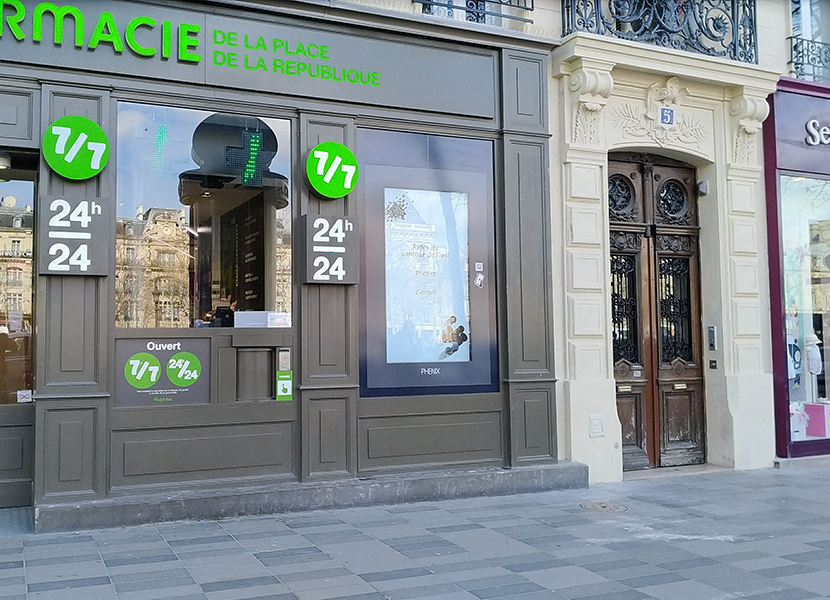Bien choisir son panneau LED publicitaire : les critères à prendre en compte

When a company wants to invest in an LED advertising panel, it is quickly faced with the problem of choice: how do you know which supplier or technology partner to trust, and which technology to choose?
This decision is all the more difficult when there is a wide range of existing solutions on the market, differing from one another in terms of screen resolution, LED panel size, product ranges and prices. When there are so many criteria for comparing existing products and services on a market, it’s not always easy to identify the one that best meets your needs.
To avoid getting lost in the decision-making process and to reduce the risk of a disappointing purchase, the best thing for a company to do is to remember that an advertising LED panel is an investment. As such, it needs to be used as part of a marketing and sales strategy, and to meet objectives set in advance. This makes it easier to identify the “right choice” of LED advertising panel: the solution that is the most convincing and proves its effectiveness.
Find out in this article what criteria to take into account when choosing your advertising LED panel!
A strategic investment: why install an LED panel, where and for what purpose?
There are a large number of formats and types of advertising LED screens, but they are not all designed to be used in the same conditions. They differ in terms of their characteristics: screen size, type of support, place of installation (indoors or outdoors, in a shop window or in the waiting area of an establishment, etc.). How do you know which one will best meet your company’s needs?
The choice of an advertising LED panel cannot be dissociated from the strategy behind the investment decision. It is essential for a company to identify the benefits it expects from an advertising LED panel. In other words, it must be fully aware of the reasons why it is choosing this type of display over all the others available.
Traditional poster holders can be effective in displaying advertising on a smaller budget. Although they do not offer the same advantages as dynamic displays. Solutions such as totems with interactive screens may be even more suitable than LED panels when audience interaction objectives are included.
Also, for the same product category, LED panels can have different levels of resistance to their environment. As in a railway station, for example, where conditions are closer to the outdoor environment. A screen designed to withstand weather conditions will therefore be functional for longer.
LED panels: an undeniable strategic challenge
LED panels excel at delivering messages. They create an immersive experience in reception or sales areas. That’s why they are ideal for advertising. Their support makes them easy to install in any location.
It is therefore preferable for a company to study the configuration of the location in which it wishes to display its messages. In order to find the place where the advertising will be most effective. Near the entry and exit points of reception or sales areas, for example, or close to the flow of people.
What’s more, thanks to their ease of installation, these types of display have the advantage of being less subject to regulations than large advertising screens. LED panels give companies a high degree of freedom in setting up their communication campaigns!

Understanding costs to help you choose your technology supplie
To choose the right advertising LED panel, a company also needs to know the cost of a display solution, and more specifically the factors that determine it.
This will make it easier to choose a specific solution and ensure that the investment is worthwhile. At the same time, it will avoid “inflating the bill” with options that do nothing to support its communication objectives.
There are several factors involved in determining the price of a digital signage system. The hardware (the screen) is not the only thing a company buys from a display solutions provider. To ensure that it remains functional in all circumstances, operations such as after-sales service are often included in the supplier’s offer.
They provide screen maintenance in the event of equipment failure. What’s more, dynamic displays can sometimes be used to develop new revenue streams.
However, such a process creates value for a company, which also entails a cost. For example, when a company succeeds in qualifying an audience in an establishment, it may allow other companies to pass on their own advertising to them.
By understanding the factors that determine the price of an advertising LED screen, a company can also discuss and negotiate more effectively with a technology supplier. It will be better able to express its needs and better understand the advantages of the solutions proposed by dynamic display specialists. These discussions will ultimately lead to the identification of the solution that best meets its needs.
Choosing the right LED screen pitch: optimising your budget and ensuring image quality
Lorsqu’une entreprise a conforté son choix d’achat d’un écran LED, il se pose la question de l’investissement optimal. Ici, elle doit réussir à évaluer la résolution dont elle a besoin selon son projet. Comment y arrive-t-elle ?
Le pitch d’un écran correspond à la caractéristique technique qui en détermine sa résolution. Il s’agit de la distance entre le centre de chaque pixel. Le pitch est donc un indicateur de la densité de pixels d’un écran : plus il est fin, plus l’image est nette. En conséquence, il permet de connaître la distance optimale de lecture. C’est-à-dire la distance minimale, séparant l’écran de la personne qui le regarde, à laquelle les contenus sont perçus sans que les pixels ne soient apparents. En d’autres termes, la distance optimale est la distance à laquelle la qualité d’image est assurée.

Depending on how it intends to use its screen, a company does not necessarily need to choose the one with the highest resolution. When it goes beyond a company’s needs, the choice of screen pitch is inappropriate for two reasons:
For reasons of cost
The price of an LED panel increases with the pixel density… And this correlation is more exponential than linear! It is therefore in a company’s best interest to choose a screen with a pitch that is adapted to the content broadcasting situation. Its needs differ depending on whether the screen is viewed from a great distance, as in a football stadium. Or whether it is installed in an exhibition, reception or sales area, at the height of the audience.
A pragmatic approach
There’s no need to think that the higher the pitch of a screen, the better its image quality in all situations… At a certain distance called the “fusion distance”, the human eye is no longer able to differentiate between pixels. A high screen pitch will therefore no longer have any impact on the perceived quality of the image. Instead, it will be its brightness, for example. The pitch of a screen determines the minimum reading distance, not the maximum!
To find out more…
The blending distance is the point at which it will be impossible for the visitor to differentiate between the pixels.
5 points to remember
1. A pitch refers to the density of pixels
2. The smaller the pitch, the higher the pixel density and resolution.
3. The size of the pitch determines the reading distance of the LED panel
4. The smaller the pitch, the closer the reading distance.
5. The size of the pitch should be chosen according to the reading distance of your visitors.
Here are some examples of reading distances and merging distances depending on the pitch:
- 1.25mm – Image merged at 2.40 m / Comfortable distance at 1.20 m
- 2mm – Image merged at 4 m / Comfortable distance at 2 m
- 2.5mm – Image merged at 6 m / Comfortable distance at 3 m
- 4mm – Merged image at 7.6 m / Comfortable distance at 3.8 m
- 6mm – Merged image at 10 m / Comfortable distance at 5 m
- 8mm – Merged image at 13 m / Comfortable distance at 6.5 m
- 10mm – Merged image at 16 m / Comfortable distance at 8 m

Take an interest in technological innovations and trends in the display market
It’s easier for companies to project themselves into the future and develop their communications. Provided it takes an interest in the innovations that are transforming the way dynamic displays are used.
LED panel: unlimited support
LED advertising panels are increasingly being adapted to the advertising needs of businesses. Thanks to the power of digital technology, they are capable of disseminating far more information than traditional billboards. They also excel at capturing audiences. In fact, moving images make better use of human functioning by attracting the eye through the principle of movement. So, to ensure that a company makes the best choice of LED advertising panel, it will be useful to determine in advance the type of content to be projected onto the screens. Depending on the mission it sets itself (presenting a product or service, developing a brand universe, etc.), certain solutions will be enhanced by technological advances capable of making all the difference.
LED panels: an all-in-one medium
Technological innovation in dynamic displays has given them other virtues. In particular, they offer advantages that go beyond the broadcasting of advertising messages. For example, as part of a CSR (Corporate Social Responsibility) policy. Companies are increasingly paying attention to the impact they have on the environment and society. Not only through their direct activities, but also indirectly through their choice of partners and suppliers. The stakeholders with whom they do business (partners, investors, customers, employees, etc.) are now sensitive to this impact on ecosystems.
Innovation in the outdoor advertising sector has enabled companies to choose more responsible solutions. Thanks to technological advances, manufacturers have been able to design LED advertising panels with screens that give off almost natural light. All the while reducing their energy consumption. They also have a very long lifespan, and manufacturers are relying more frequently on equipment recycling operations. This helps to limit the impact of their activities on the environment.
In conclusion…
In conclusion, you need to think the project through if you want to choose the right LED advertising panels. A company needs to know what it wants from them beforehand so that it can choose the most appropriate solution, while staying within its budget. Consideration needs to be given to the size of the screen, the medium, the resolution, etc. It also needs to consider the environment in which the display solutions will be installed. And don’t hesitate to seek advice from technology suppliers. As specialists, they can help you think strategically and identify the solution that best meets your image and brand awareness objectives.
In the same
categorie

Dynamic displays in pharmacies: how to boost performance and combat the epidemic?

Digital signage: what’s in it for retailers?
